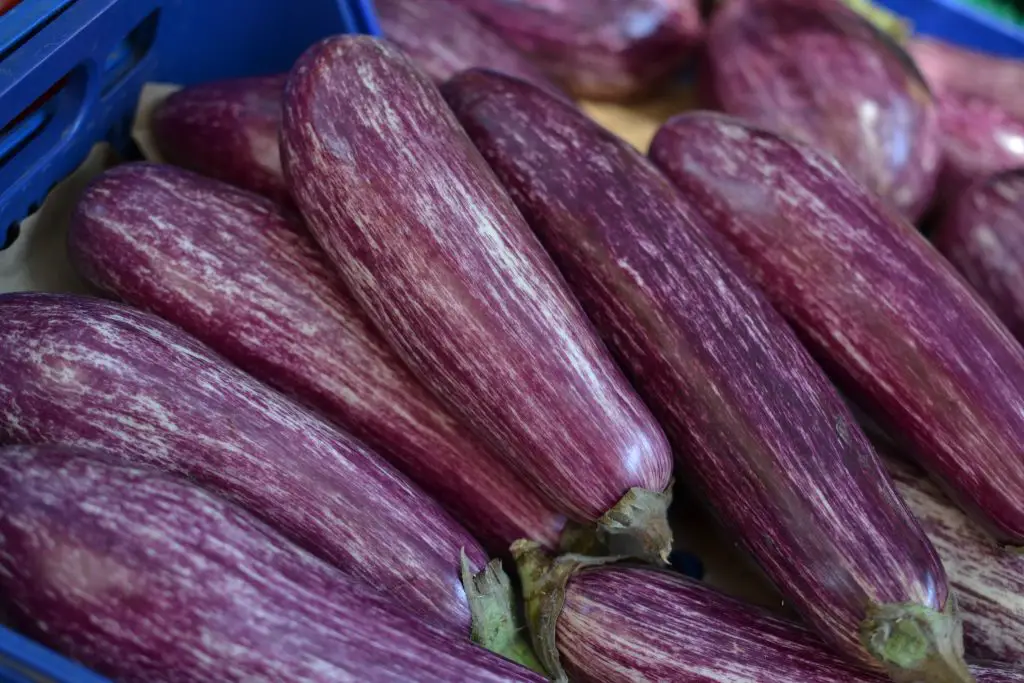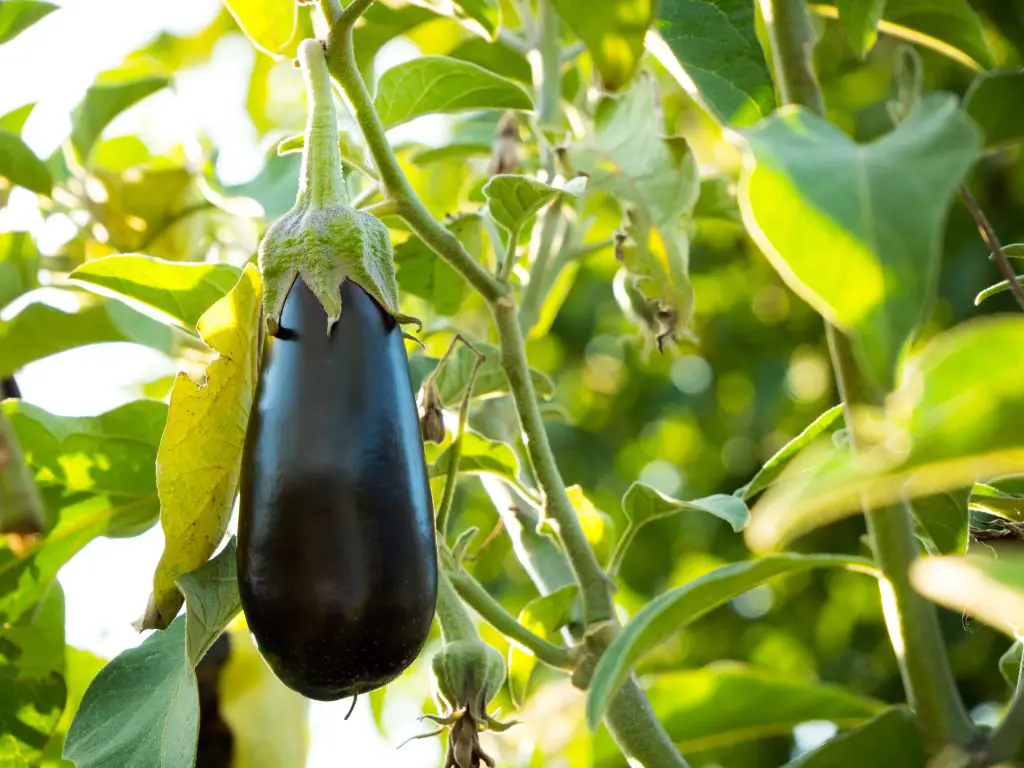How Many Eggplants Does One Plant Yield? Eggplants (also known as Aubergines) are a widely used vegetable in cooking today. Despite being heavily associated with Mediterranean cuisine Eggplants are believed to have originated in India and were widely grown in South East Asia for thousands of years.
Most people picture an oblong-shaped black fruit the size of a small melon (Black Beauty variety) when thinking of eggplants. However, there is a wide range of varieties that include white and purple varieties that come in all shapes and sizes from very small round ones to long thin varieties that are around 1 to 2 ft (30 to 60cm) long.
A single Eggplant plant will produce between 8 and 20 fruits per plant which equates to a yield between 3.5 to 8.5 lbs (1.5 to 3.8 kg) depending upon the variety. The Black Beauty, one of the most widely grown varieties produces around 10 fruits per plant which weigh around 6.6 lbs (3 kg) according to the study by Purdue University.
What Is The Best Of Eggplant Variety To Grow?
Purdue University carried out a study on the 13 different varieties of Eggplants. In this study, the number of fruit, the yield by weight, and days to harvest were assessed. The results of this study are summarised in the table below. Where an article has been found on a specific variety a link to that article has been provided in the table.
| Variety | Seed Type | Days to First Harvest | Fruit Per Plant | Yield Per Plant (lbs) | Yield Per Plant (Kgs) |
| Beatrice | F1 Hybrid | 93 | 13.4 | 8.6 | 3.9 |
| Italian Galine | F1 Hybrid | 93 | 13.9 | 7.6 | 3.4 |
| Classic | F1 Hybrid | 93 | 13.2 | 7.6 | 3.4 |
| Clara | F1 Hybrid | 93 | 12.3 | 6.9 | 3.2 |
| White Tango | ? | 93 | 23.1 | 6.8 | 3.1 |
| Black Beauty | Heirloom | 100 | 10.0 | 6.6 | 3.0 |
| Dancer | F1 Hybrid | 93 | 15.9 | 6.3 | 2.9 |
| Florida Market | Heirloom | 100 | 9.6 | 6.3 | 2.8 |
| Rosa Bianca | Heirloom | 100 | 8.9 | 5.6 | 2.6 |
| Twinkle | F1 Hybrid | 93 | 14.9 | 5.6 | 2.6 |
| Mangan | F1 Hybrid | 89 | 10.8 | 4.0 | 1.8 |
| Orient Charming | F1 Hybrid | 93 | 13.4 | 3.6 | 1.6 |
| Machiaw | F1 Hybrid | 100 | 18.0 | 3.3 | 1.5 |
In the study it was observed that several of the hybrid varieties out performed Black Beauty for yield and days to harvest. Black Beauty is one of the most popular cultivars dating back to the early 1900s. It is generally described as a high yielding and early maturing variety that is well-suited option for those with shorter growing seasons. As such it serves as a useful comparison against the new hybrid varieties.
Apart from the slight improvements in yield exhibited by the top varieties it was also observed that the percentage of fruit that was ready to harvest early in the season was significantly higher for the hybrids. In some cases 25% of the fruit that was harvest ready prior to 1st August compared to 7% for Black Beauty.
This indicates that those living in regions with short-season would benefit from growing hybrid such as Italian Galine which is similar in appearance to Black Beauty. In practical terms, it would likely bring the harvest forward by 2-3 weeks. However, it was also noted that the white varieties such as White Tango and Clara tended to mark more easily than darker-skinned varieties.

Based on this our preferred hybrid variety is Italian Galine or Black Beauty for an heirloom variety. However, it should be noted that the key disadvantage of selecting a hybrid seed is that you cannot collect the seed for use in the following season. To read more about how hybrid seeds differ from heirloom varieties click here.
How To Grow Eggplants
The Eggplants is a member of the Solanaceae family which includes Tomatoes and Peppers. All the plants within this family are frost-sensitive plants that are generally treated as annuals by most gardeners even though they are perennials plants in frost-free environments.
If you live in a region that does get frosts it is best to plant seeds in trays undercover, particularly at the start of the growing season as Eggplants prefer warmer conditions. It is best to store the trays in a heated area within your house or alternatively use a heated propagation tray.
I personally find that heated propagation trays work better because it is easier to control the growing environment and provide the ideal conditions for the seeds. These trays are relatively inexpensive and well worth the investment when growing heat-loving plants like Tomatoes, Peppers, and Eggplants. Click here to see the latest price on Amazon.

When sowing the seeds they should be planted in seed raising mix at a depth of 0.5 inches (1 to 2 cm). It is best to plant 2 seeds per cell to ensure all the cell are occupied in the tray. If both seedlings germinate then thin to strongest plant.
If you live in the UK we recommend visiting Thompson and Morgan’s Website as they have a broad range of seeds available. If you live in the US try Seeds For Generations or St Clare Seeds as both companies are family-run businesses that specialize in Heirloom seeds.
The seedlings will take approximately 4 to 6 weeks to reach sufficient size to be able to be planted outside into the garden. This should only be done when the risk of frost has passed. It is also preferable that the temperatures outside be at least 60°F (15°C) or warmer.
If you live in a region that prone to late cold snaps it is advisable to protect the plant with a row cover as this will ensure that the plants remain relatively warm. Row covers also come in handy at the end of the season as they can be used to extend the growing season by a week of two.
If you are intending on buying a row cover it is important to ensure that it is relatively tall as Eggplants can get reasonably tall particularly at the end of the season. The product we recommend is the Growsun Garden Tunnel Plant Cover which is shown in the picture below.

When planting the seedlings out into the garden they should be spaced approximately 12 to 16 inches (30 to 40 cm) apart in soil that is moist and contains plenty of organic matter. To achieve the ideal growing conditions we generally recommend using the “No Dig” method because it is a simple and easy method that reduces the volume of work in the garden.
The No-Dig method required a layer of compost, 2 to 4 inches (5 to 10 cm) thick, to be applied to the surface of the soil once a year. This application is sufficient to supply nutrients to the soil for the entire year. Additionally, the layer of compost acts as a mulch suppressing the weeds. To read more about how to use this method to reduces the volume of work in the garden click here.
Once established ensure that the plants remain well watered through the growing season. Failure to supply sufficient moisture will result in the production of fruits that are small and bitter.
As the Eggplants mature they can become prone to falling over as the weight of the fruit increases as result support may be required. While individual stakes will provide support for individual branches my preference is to use a tomato cage. The reason for this is that the tomato cage provides greater stability for the plant and it can be installed around the plant at any stage without disturbing the roots of the plant.

The fruit will be ready to harvest approximately 100 days after the seed is planted and will continue to produce fruit until the first frost arrives which is typically 2 to 3 months later. When harvesting fruit it is sometimes difficult to tell when the fruit is ripe. Both under and overripe can taste bitter if picked too early or too late.
The most obvious sign that a fruit is ripe is it will develop a glossy coating whereas dull coatings indicate that the fruit is overripe. Another way to determine if they are ripe is to gently squeeze the eggplant. Once you release the fruit, the skin should bounce back, if indentations remain, the fruit is not quite ripe yet.
When harvesting the fruit use pruning shears to cut the stem because the fruits will not pull free by hand easily. Once harvested the fruit will store in a refrigerator for several days.
